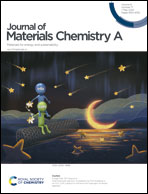The highly efficient collection of underwater oil droplets on an anisotropic porous cone surface via an electric field†
Abstract
Achieving the directional transport of micron-sized liquid droplets in aqueous media and using such transport to rapidly and highly efficiently collect tiny oil droplets continuously on a surface are still challenging endeavors. Herein, we present a new strategy to achieve the highly efficient directional collection of micron-sized underwater oil droplets on an anisotropic porous polystyrene (PS) film-coated cone surface under an applied electric field. The results revealed that underwater oil droplets can be continuously and directionally transported from the tip of the cone to its base along the anisotropic porous cone surface under the cooperative driving force of a Laplace pressure gradient, resulting from the geometric cone gradient and surface porous microstructure gradient, and buoyant force with the assistance of electrocapillary pressure. Based on the above theoretical and experimental results, an integrated device with an array of porous PS-coated cones was fabricated, and achieved the highly efficient collection of oil from an oil–water mixture. We expect this work to open new avenues to improve the treatment of oily water, and also to be useful for constructing artificial directional transport systems for catalytic reactions, energy transfer, selective separation, and micro/nanofluidic devices.



 Please wait while we load your content...
Please wait while we load your content...